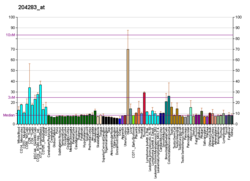FARS2
| FARS2 | |||||||||||||||||||||||||||||||||||||||||||||||||||
|---|---|---|---|---|---|---|---|---|---|---|---|---|---|---|---|---|---|---|---|---|---|---|---|---|---|---|---|---|---|---|---|---|---|---|---|---|---|---|---|---|---|---|---|---|---|---|---|---|---|---|---|
 | |||||||||||||||||||||||||||||||||||||||||||||||||||
| |||||||||||||||||||||||||||||||||||||||||||||||||||
| Identifiers | |||||||||||||||||||||||||||||||||||||||||||||||||||
| Aliases | FARS2,COXPD14, FARS1, HSPC320, PheRS, dJ520B18.2, phenylalanyl-tRNA synthetase 2, mitochondrial, SPG77, mtPheRS | ||||||||||||||||||||||||||||||||||||||||||||||||||
| External IDs | OMIM:611592;MGI:1917205;HomoloGene:4788;GeneCards:FARS2;OMA:FARS2 - orthologs | ||||||||||||||||||||||||||||||||||||||||||||||||||
| |||||||||||||||||||||||||||||||||||||||||||||||||||
| |||||||||||||||||||||||||||||||||||||||||||||||||||
| |||||||||||||||||||||||||||||||||||||||||||||||||||
| |||||||||||||||||||||||||||||||||||||||||||||||||||
| |||||||||||||||||||||||||||||||||||||||||||||||||||
| Wikidata | |||||||||||||||||||||||||||||||||||||||||||||||||||
| |||||||||||||||||||||||||||||||||||||||||||||||||||
Phenylalanyl-tRNA synthetase, mitochondrial (FARS2)is anenzymethat in humans is encoded by theFARS2gene.[5]Thisproteinencoded byFARS2localizes to themitochondrionand plays a role in mitochondrialprotein translation.Mutationsin this gene have been associated with combined oxidative phosphorylation deficiency 14, also known as Alpers encephalopathy, as well asspastic paraplegia77 and infantile-onsetepilepsyandcytochrome c oxidasedeficiency.[6][7]
Structure
[edit]FARS2is located on thep armofchromosome 6in position 25.1 and has 15exons.[6]This gene encodes a member of theclass-II aminoacyl-tRNA synthetasefamily.[8][9]FARS2 is a phenylalanine-tRNAsynthetase(PheRS) localized to themitochondrionwhich consists of a singlepolypeptide chain,unlike the ( Alpha -beta)2 structure of theprokaryoticandeukaryoticcytoplasmicforms of PheRS. Structure analysis andcatalyticproperties indicate mitochondrial PheRSs may constitute a class of PheRS distinct from the enzymes found in prokaryotes and in the eukaryotic cytoplasm.[6]
Function
[edit]Aminoacyl-tRNA synthetasesare a class ofenzymesthat chargetRNAswith their cognateamino acids.[6]FARS2 charges tRNA(Phe) withphenylalanineand catalyzes direct attachment of m-Tyr (an oxidized version of Phe) to tRNA(Phe). This makes it important for mitochondrialtranslationand for delivery of the misacylated tRNA to theribosomeand incorporation ofROS-damaged amino acid into proteins.[8][9][10][11]Alternative splicingresults in multiple transcript variants.[6]
Catalytic activity
[edit]ATP+ L-phenylalanine+tRNA(Phe) =AMP+diphosphate+ L-phenylalanyl-tRNA(Phe)[8][9][10][11]
Clinical significance
[edit]Mutations inFARS2have been associated to combined oxidative phosphorylation deficiency 14,spastic paraplegia77, and infantile-onsetepilepsyandcytochrome c oxidasedeficiency. Both combined oxidative phosphorylation deficiency 14 and spastic paraplegia 77 areautosomal recessivein nature and have been linked to several pathogenic variants including Y144C,[12]I329T, D391V,[11]and D142Y.[13]Combined oxidative phosphorylation deficiency 14 is characterized by neonatal onset ofglobal developmental delay,refractoryseizures,lactic acidosis,and deficiencies of multiple mitochondrial respiratory enzymes. Spastic paraplegia, meanwhile, is aneurodegenerative disordercharacterized by a slow, gradual, progressive weakness andspasticityof the lower limbs, with patients often exhibiting difficulty with balance, weakness and stiffness in the legs,muscle spasms,and dragging the toes when walking.[8][9]One case of infantile-onset epilepsy and cytochrome c oxidase deficiency resulting from aFARS2Asp325Tyrmissense mutationhas also been reported. Early-onset epilepsy,neurological deficits,andcomplex IVdeficiency are the main characteristics of the disease stemming from this mutation.[7]
Interactions
[edit]FARS2 has been shown to have 193 binaryprotein-protein interactionsincluding 12 co-complex interactions. FARS2 appears to interact withRCBTB2,KRTAP10-9,CALCOCO2,KRT40,MID2,APPL1,IKZF3,KRT13,TADA2A,STX11,TRIM27,KRTAP10-5, KRTAP10-7,TFCP2,MKRN3,KRT31,HMBOX1,AGTRAP,ADAMTSL4,NOTCH2NL,CMTM5, TRIM54, FSD2, CYSRT1, HIGD1C, homez,SPRY1,ZNF500,KRT34,YIF1A,BAG4,TPM2,SYP, KRTAP10-8, KRTAP1-1,AP1B1,TRAF2,GRB10,MESD,TRIP6,CCDC152, BEX5,FHL5,MORN3, DGAT2L6, ZNF438, KCTD17,ZNF655,BANP,SPERT,NFKBID,ZNF526,PCSK5,DVL3,AJUBA, PPP1R16B,MDFI,DPH2, CDCA4, KRTAP3-3,BACH2,KCNF1,MAN1C1, RIMBP3,ZRANB1,ISY1,FKBP7,and E7.[14]
References
[edit]- ^abcGRCh38: Ensembl release 89: ENSG00000145982–Ensembl,May 2017
- ^abcGRCm38: Ensembl release 89: ENSMUSG00000021420–Ensembl,May 2017
- ^"Human PubMed Reference:".National Center for Biotechnology Information, U.S. National Library of Medicine.
- ^"Mouse PubMed Reference:".National Center for Biotechnology Information, U.S. National Library of Medicine.
- ^Bullard JM, Cai YC, Demeler B, Spremulli LL (May 1999). "Expression and characterization of a human mitochondrial phenylalanyl-tRNA synthetase".Journal of Molecular Biology.288(4): 567–77.doi:10.1006/jmbi.1999.2708.PMID10329163.
- ^abcde"Entrez Gene: FARS2 phenylalanyl-tRNA synthetase 2, mitochondrial".
 This article incorporates text from this source, which is in thepublic domain.
This article incorporates text from this source, which is in thepublic domain.
- ^abAlmalki A, Alston CL, Parker A, Simonic I, Mehta SG, He L, Reza M, Oliveira JM, Lightowlers RN, McFarland R, Taylor RW, Chrzanowska-Lightowlers ZM (January 2014)."Mutation of the human mitochondrial phenylalanine-tRNA synthetase causes infantile-onset epilepsy and cytochrome c oxidase deficiency".Biochimica et Biophysica Acta (BBA) - Molecular Basis of Disease.1842(1): 56–64.doi:10.1016/j.bbadis.2013.10.008.PMC3898479.PMID24161539.
- ^abcd"FARS2 - Phenylalanine--tRNA ligase, mitochondrial precursor - Homo sapiens (Human) - FARS2 gene & protein".uniprot.org.Retrieved2018-09-05.
 This article incorporates text available under theCC BY 4.0license.
This article incorporates text available under theCC BY 4.0license.
- ^abcd"UniProt: the universal protein knowledgebase".Nucleic Acids Research.45(D1): D158–D169. January 2017.doi:10.1093/nar/gkw1099.PMC5210571.PMID27899622.
- ^abKlipcan L, Moor N, Kessler N, Safro MG (July 2009)."Eukaryotic cytosolic and mitochondrial phenylalanyl-tRNA synthetases catalyze the charging of tRNA with the meta-tyrosine".Proceedings of the National Academy of Sciences of the United States of America.106(27): 11045–8.Bibcode:2009PNAS..10611045K.doi:10.1073/pnas.0905212106.PMC2700156.PMID19549855.
- ^abcElo JM, Yadavalli SS, Euro L, Isohanni P, Götz A, Carroll CJ, Valanne L, Alkuraya FS, Uusimaa J, Paetau A, Caruso EM, Pihko H, Ibba M, Tyynismaa H, Suomalainen A (October 2012)."Mitochondrial phenylalanyl-tRNA synthetase mutations underlie fatal infantile Alpers encephalopathy".Human Molecular Genetics.21(20): 4521–9.doi:10.1093/hmg/dds294.PMID22833457.
- ^Shamseldin HE, Alshammari M, Al-Sheddi T, Salih MA, Alkhalidi H, Kentab A, Repetto GM, Hashem M, Alkuraya FS (April 2012). "Genomic analysis of mitochondrial diseases in a consanguineous population reveals novel candidate disease genes".Journal of Medical Genetics.49(4): 234–41.doi:10.1136/jmedgenet-2012-100836.PMID22499341.S2CID5856138.
- ^Yang Y, Liu W, Fang Z, Shi J, Che F, He C, Yao L, Wang E, Wu Y (February 2016)."A Newly Identified Missense Mutation in FARS2 Causes Autosomal-Recessive Spastic Paraplegia".Human Mutation.37(2): 165–9.doi:10.1002/humu.22930.PMID26553276.S2CID46241711.
- ^"193 binary interactions found for search term FARS2".IntAct Molecular Interaction Database.EMBL-EBI.Retrieved2018-09-05.
Further reading
[edit]- Levin I, Kessler N, Moor N, Klipcan L, Koc E, Templeton P, Spremulli L, Safro M (September 2007)."Purification, crystallization and preliminary X-ray characterization of a human mitochondrial phenylalanyl-tRNA synthetase".Acta Crystallographica Section F.63(Pt 9): 761–4.doi:10.1107/S1744309107038651.PMC2376306.PMID17768348.
- Brandenberger R, Wei H, Zhang S, Lei S, Murage J, Fisk GJ, Li Y, Xu C, Fang R, Guegler K, Rao MS, Mandalam R, Lebkowski J, Stanton LW (June 2004). "Transcriptome characterization elucidates signaling networks that control human ES cell growth and differentiation".Nature Biotechnology.22(6): 707–16.doi:10.1038/nbt971.PMID15146197.S2CID27764390.
- Harrington JJ, Sherf B, Rundlett S, Jackson PD, Perry R, Cain S, Leventhal C, Thornton M, Ramachandran R, Whittington J, Lerner L, Costanzo D, McElligott K, Boozer S, Mays R, Smith E, Veloso N, Klika A, Hess J, Cothren K, Lo K, Offenbacher J, Danzig J, Ducar M (May 2001). "Creation of genome-wide protein expression libraries using random activation of gene expression".Nature Biotechnology.19(5): 440–5.doi:10.1038/88107.PMID11329013.S2CID25064683.
- Suzuki Y, Yoshitomo-Nakagawa K, Maruyama K, Suyama A, Sugano S (October 1997). "Construction and characterization of a full length-enriched and a 5'-end-enriched cDNA library".Gene.200(1–2): 149–56.doi:10.1016/S0378-1119(97)00411-3.PMID9373149.
- Maruyama K, Sugano S (January 1994). "Oligo-capping: a simple method to replace the cap structure of eukaryotic mRNAs with oligoribonucleotides".Gene.138(1–2): 171–4.doi:10.1016/0378-1119(94)90802-8.PMID8125298.
External links
[edit]- Nuclear Gene-Encoded Leigh Syndrome Overview
- Mitochondrial DNA-Associated Leigh Syndrome and NARP
- Overview of all the structural information available in thePDBforUniProt:O95363(Phenylalanine--tRNA ligase, mitochondrial) at thePDBe-KB.
This article incorporates text from theUnited States National Library of Medicine,which is in thepublic domain.






